 |
 |
 |
| |
Impact of smoking, hypertension, and cholesterol on myocardial infarction in HIV-infected adults...."hypertension, cholesterol & smoking are very strong drivers of MIs in HIV+"
|
| |
| |
Reported by Jules Levin
CROI 2017 Feb 14-16 Seattle, WA
Keri N Althoff1, Frank Palella2, Kelly Gebo1, Stephen J Gange1,
Charles Rabkin3, Jennifer Thorne1, Michael Horberg4, Daniel B.
Klein5, Mari Kitahata6, and Richard D Moore1 for the North
American AIDS Cohort Collaboration on Research and Design
On the basis of the MI analysis, the NA-ACCORD team proposed that the high MI burden in people with HIV can be reduced by addressing high total cholesterol, hypertension, smoking, and HCV, and by treating HIV to avoid low CD4 counts and detectable viral loads. Overall, they stress that "interventions to prevent cancer, end-stage renal disease, end-stage liver disease, and MIs must expand beyond successful antiretroviral therapy to address traditional risk factors."
"hypertension, cholesterol & smoking are very strong drivers of MIs in HIV+"......"Interventions to prevent cancer, ESRD, ESLD, and MIs must expand beyond successful ART to address traditional risk factors"
[ from Jules: I will say it again: THE MOST IMPORTANT issue for older patients - 50% are over 50 in the US/20% over 60, and 80% over 45 - is AGING & the severe harsh affects devatasting many older patients: premature frailty, cognitive impairment, neuropathy, bone disease/falls & fractures, cardiovascular disease & cancers, NOT PrEP & CURE 7 years we are working on Cure without real progress- until advocates & government officials recognize this they are betraying this group of patients. This was the first HIV-infected group from back in the 19080s & 1990s and they have been thrown of the heap of discarded without the due attention they deserve by advocates & government officials. Wake up! ]
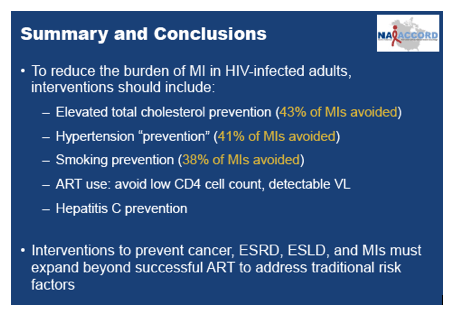
Total Cholesterol, Hypertension, Smoking Contribute Most to MIs in HIV Group
Conference on Retroviruses and Opportunistic Infections (CROI), February 13-16, 2017, Seattle
Mark Mascolini
Lowering high total cholesterol would prevent 43% of myocardial infarctions (MIs) in people with HIV, according to a 29,515-person analysis of the NA-ACCORD cohorts [1]. Avoiding hypertension would prevent 41% of MIs, and avoiding smoking would prevent 38%.
Adults with HIV run a higher risk of MI than the general population. Traditional cardiovascular risk factors like hyperlipidemia and smoking certainly contribute to this risk in people with HIV, but the relative contribution of traditional risk factors and HIV-related factors remains poorly understood. To address this question, NA-ACCORD investigators analyzed their combined cohorts to estimate the population-attributable fraction (PAF) for MI associated with HIV-related and traditional risk factors. For this analysis PAF means "the proportion of MIs that could be avoided in HIV-infected adults if all were unexposed to the modifiable risk factor of interest," if other variables are held constant [2].
The North American AIDS Cohort Collaboration on Research and Design (NA-ACCORD) combines cohorts in the United States and Canada. The cohort population is demographically similar to the adult US HIV population. This analysis involved 7 cohorts assessed for incident (new) MIs from January 2000 through December 2013. Incident type 1 MIs were validated by MESA criteria, the universal MI definition, and experts in the field.
Modifiable risk factors of interest were cigarette smoking, elevated total cholesterol, treated hypertension, diabetes, stage 4 chronic kidney disease (CKD), CD4 count below 200, HIV RNA in plasma (viral load) at or above 400 copies, clinical AIDS diagnosis, HCV coinfection, and (in sensitivity analyses) body mass index (BMI) in cohort members who had BMI data available. PAF considers prevalence of the risk factor in cohort members with MI and the adjusted hazard ratio (aHR) for that risk factor [2]. All PAF analyses adjusted for all modifiable risk factors, age, sex, and race. This analysis could not evaluate HIV as an independent risk factor because all participants had HIV infection.
The study population consisted of 29,515 adults with HIV. Through a median follow-up of 3.5 years, there were 347 MIs. Several risk factors were more prevalent in people with an MI than in people without an MI: smoking (84% versus 75%), elevated total cholesterol (61% versus 25%), treated hypertension (26% versus 10%), diabetes (8% versus 3%), CD4 count below 200 (32% versus 24%), clinical AIDS diagnosis (31% versus 22%), and HCV infection (27% versus 18%). In the BMI-adjusted analysis, stage 4 CKD was also more prevalent in the MI group (7% versus 2%).
In the analysis considering BMI, adjusted hazard ratios (aHR) identified 7 independent MI predictors: ever smoking versus never (aHR 1.7, 95% confidence interval [CI] 1.0 to 2.8); elevated total cholesterol (aHR 3.1, 95% CI 2.3 to 4.2), treated hypertension (aHR 2.9, 95% CI 2.2 to 4.0), diabetes (aHR 1.5, 95% CI 1.1 to 2.1), stage 4 CKD (aHR 1.8, 95% CI 1.0 to 3.0), CD4 count below 200 (aHR 2.4, 95% CI 1.6 to 3.6), and HCV infection (aHR 1.8, 95% CI 1.3 to 2.4).
PAFs were highest for elevated total cholesterol (43%), treated hypertension (41%), and smoking (38%). Those PAFs meant 43% of MIs in this population could be avoided if no one ever had elevated total cholesterol, 41% could be avoided if no one ever had hypertension, and 38% could be avoided if no one ever smoked. In the analysis adjusted for BMI, PAFs were 39% for elevated total cholesterol, 39% for treated hypertension, and 36% for smoking. The next-highest PAFs in the BMI-adjusted analysis were for HCV infection (14%), CD4 count below 200 (14%), and viral load above 400 copies (8%).
Previous research identified high PAFs in HIV populations for cancer (smoking 35%; smoking 26% after excluding lung cancer), end-stage renal disease (elevated total cholesterol 22%), and end-stage liver disease (at-risk alcohol use 33%; HCV infection 31%).
On the basis of the MI analysis, the NA-ACCORD team proposed that the high MI burden in people with HIV can be reduced by addressing high total cholesterol, hypertension, smoking, and HCV, and by treating HIV to avoid low CD4 counts and detectable viral loads. Overall, they stress that "interventions to prevent cancer, end-stage renal disease, end-stage liver disease, and MIs must expand beyond successful antiretroviral therapy to address traditional risk factors."
References
1. Althoff KN, Palella FJ, Gebo K, et al. Impact of smoking, hypertension and cholesterol on myocardial infarction in HIV+ adults. Conference on Retroviruses and Opportunistic Infections (CROI), February 13-16, 2017, Seattle. Abstract 130.
2. Laaksonen MA, Virtala E, Knekt P, Oja H, Harkanen T. SAS macros for calculation of population attributable fraction in a cohort study design. J Stats Software. 2011;43:1-25. https://www.jstatsoft.org/article/view/v043i07/v43i07.pdf
--------------------------------
Reported by Jules Levin
CROI 2017 Feb 14-16 Seattle, WA
Keri N Althoff1, Frank Palella2, Kelly Gebo1, Stephen J Gange1, Charles Rabkin3, Jennifer Thorne1, Michael Horberg4, Daniel B. Klein5, Mari Kitahata6, and Richard D Moore1 for the North American AIDS Cohort Collaboration on Research and Design
WEBCAST: http://www.croiwebcasts.org/console/player/33601?mediaType=slideVideo&
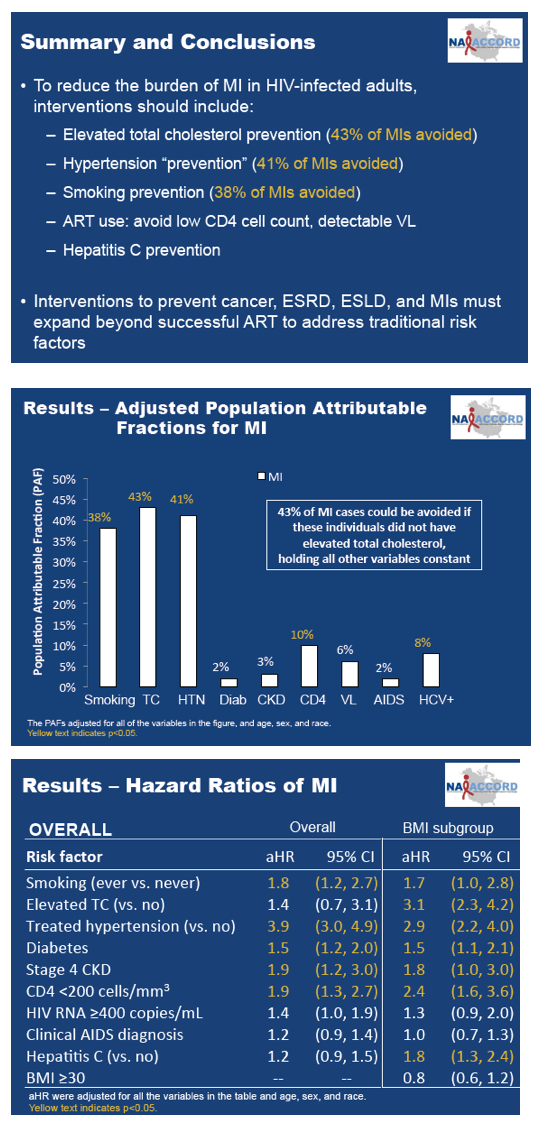
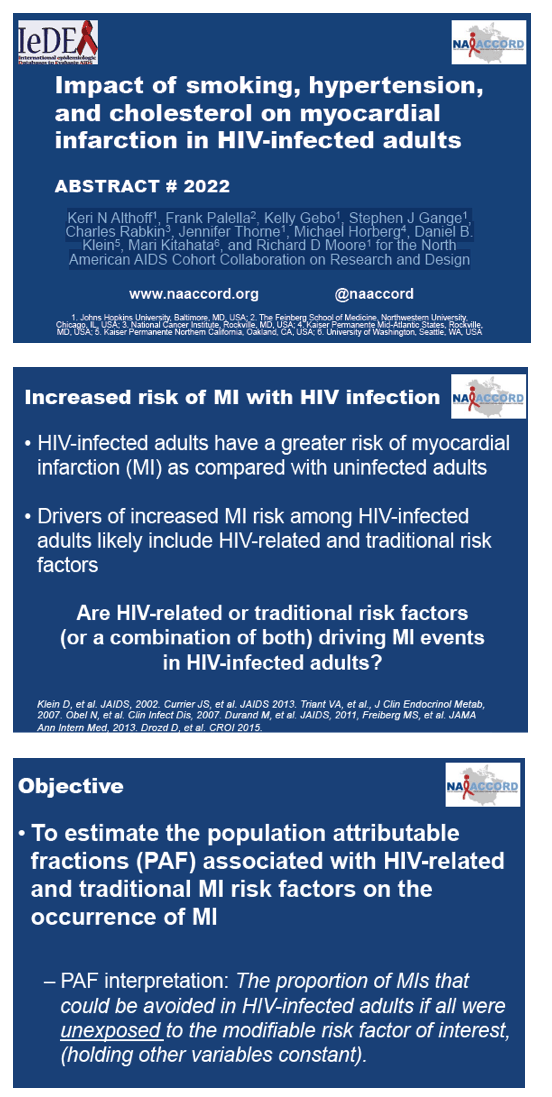
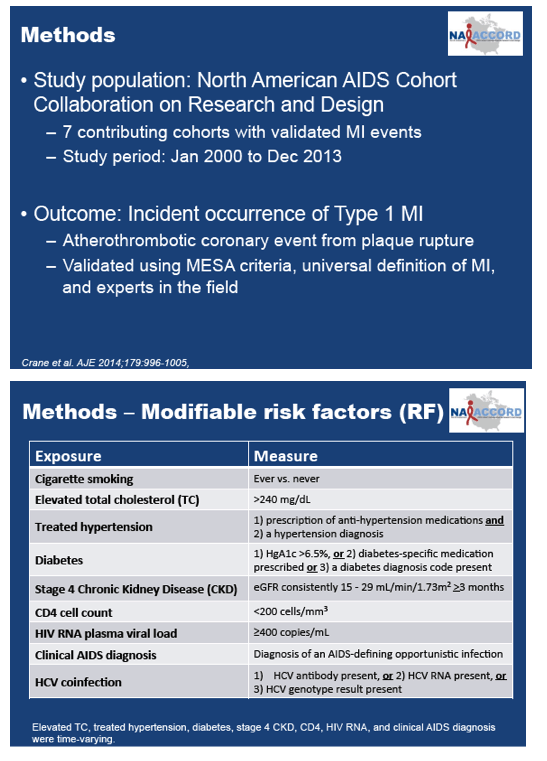
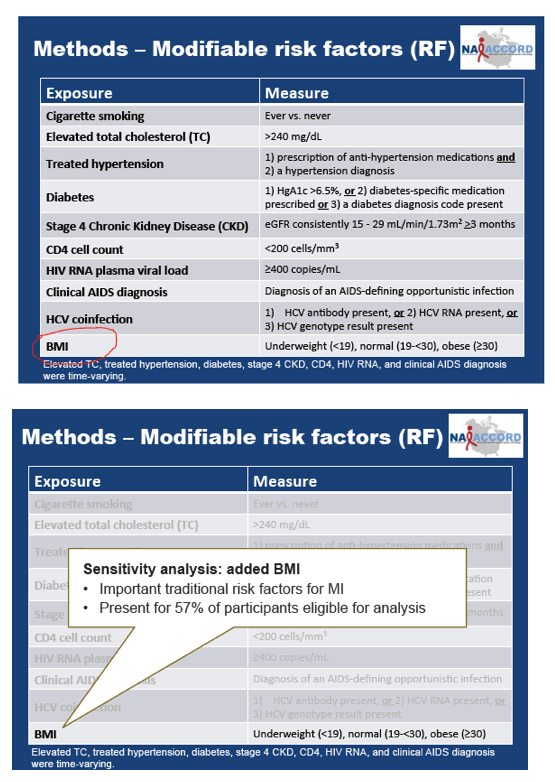


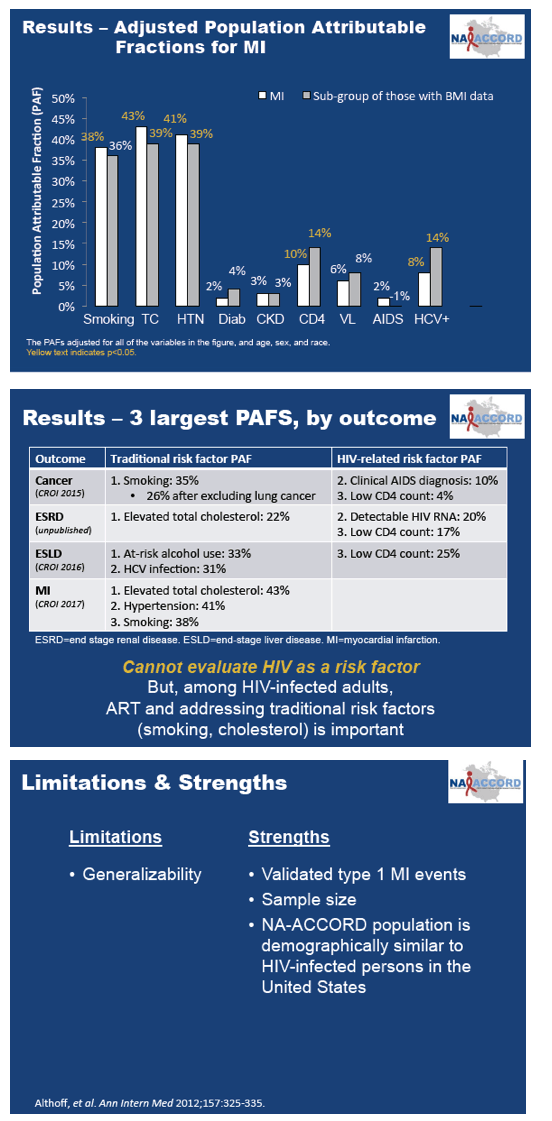
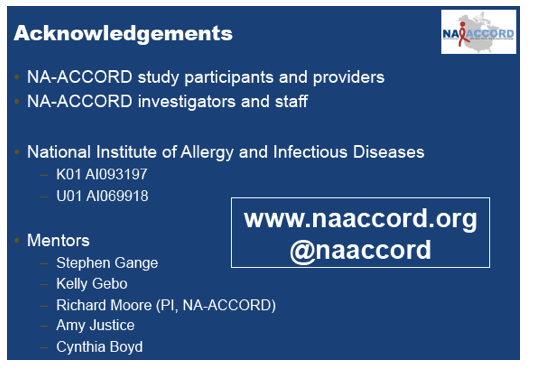
|
| |
|
 |
 |
|
|